Factors Affecting Teamwork in Organizations
VerifiedAdded on 2020/07/22
|15
|4091
|41
AI Summary
The provided assignment discusses the various factors that affect team work in an organization. It mentions diversity among employees as a potential psychological barrier to change, effective communication for successful teamwork, and proper leadership by managers to achieve organizational targets. The document also references several books and journals on teamwork assessment, team performance management, and information security program effectiveness. A summary of the benefits of teamwork in business is also provided.
Contribute Materials
Your contribution can guide someone’s learning journey. Share your
documents today.
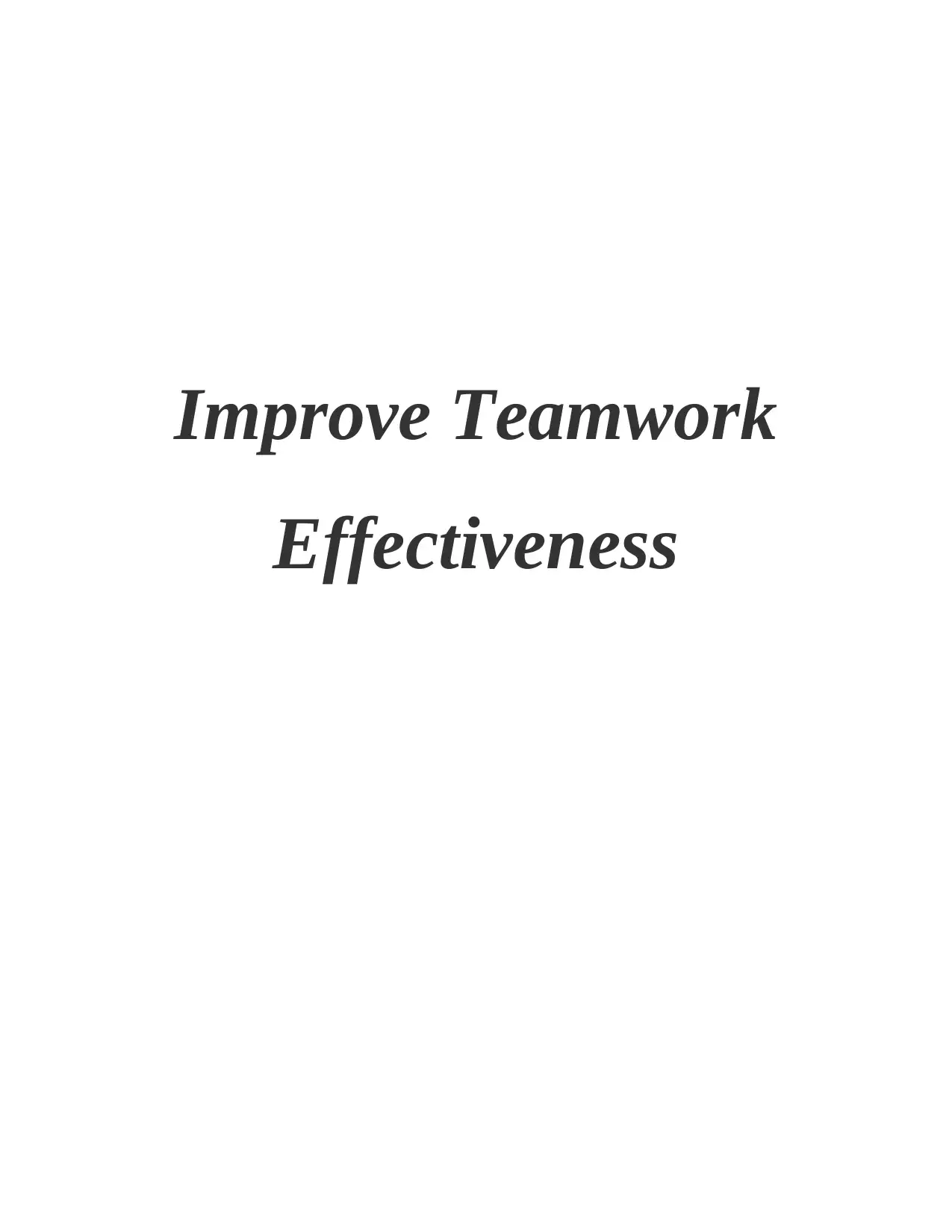
Improve Teamwork
Effectiveness
Effectiveness
Secure Best Marks with AI Grader
Need help grading? Try our AI Grader for instant feedback on your assignments.
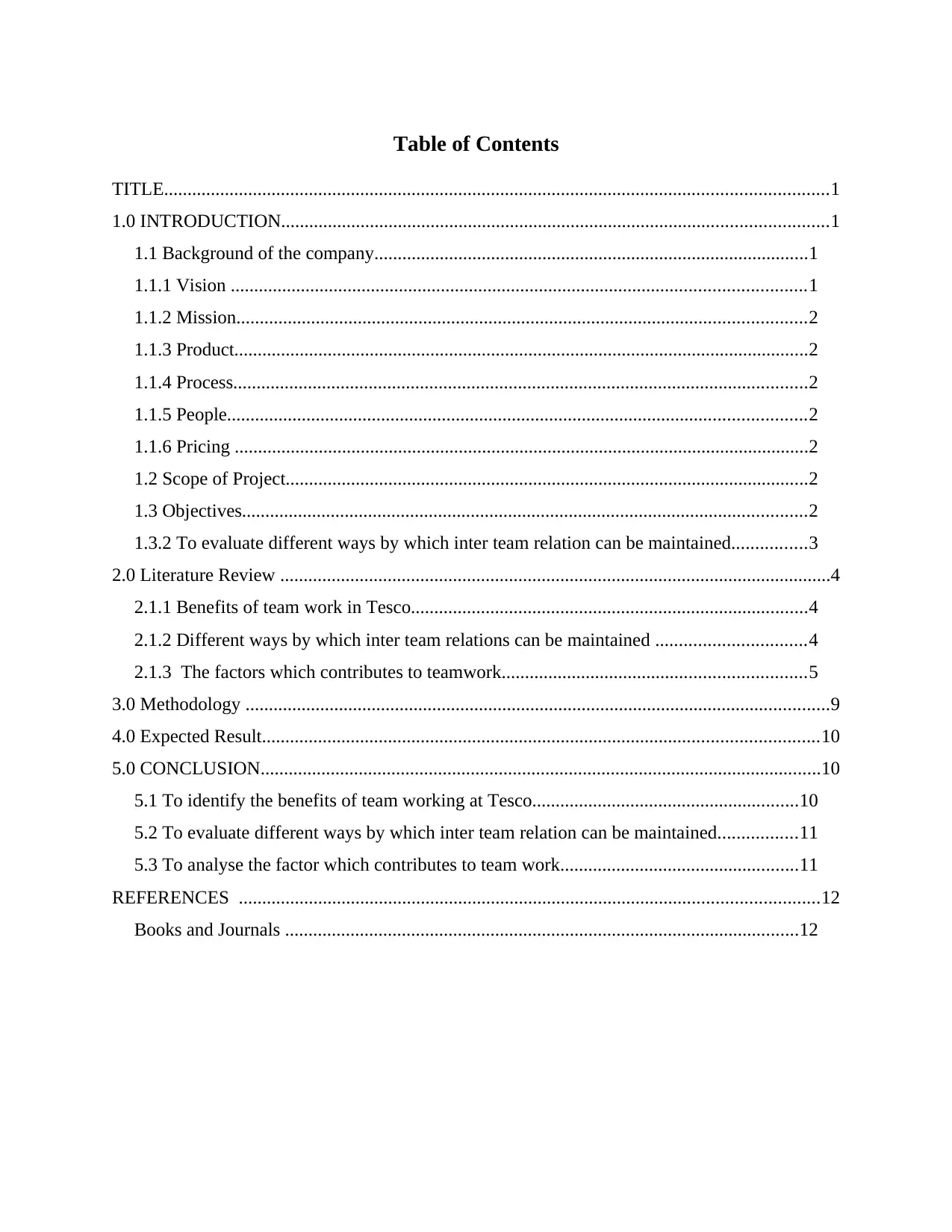
Table of Contents
TITLE..............................................................................................................................................1
1.0 INTRODUCTION.....................................................................................................................1
1.1 Background of the company.............................................................................................1
1.1.1 Vision ...........................................................................................................................1
1.1.2 Mission..........................................................................................................................2
1.1.3 Product...........................................................................................................................2
1.1.4 Process...........................................................................................................................2
1.1.5 People............................................................................................................................2
1.1.6 Pricing ...........................................................................................................................2
1.2 Scope of Project................................................................................................................2
1.3 Objectives.........................................................................................................................2
1.3.2 To evaluate different ways by which inter team relation can be maintained................3
2.0 Literature Review ......................................................................................................................4
2.1.1 Benefits of team work in Tesco.....................................................................................4
2.1.2 Different ways by which inter team relations can be maintained ................................4
2.1.3 The factors which contributes to teamwork.................................................................5
3.0 Methodology .............................................................................................................................9
4.0 Expected Result.......................................................................................................................10
5.0 CONCLUSION........................................................................................................................10
5.1 To identify the benefits of team working at Tesco.........................................................10
5.2 To evaluate different ways by which inter team relation can be maintained.................11
5.3 To analyse the factor which contributes to team work...................................................11
REFERENCES ............................................................................................................................12
Books and Journals ..............................................................................................................12
TITLE..............................................................................................................................................1
1.0 INTRODUCTION.....................................................................................................................1
1.1 Background of the company.............................................................................................1
1.1.1 Vision ...........................................................................................................................1
1.1.2 Mission..........................................................................................................................2
1.1.3 Product...........................................................................................................................2
1.1.4 Process...........................................................................................................................2
1.1.5 People............................................................................................................................2
1.1.6 Pricing ...........................................................................................................................2
1.2 Scope of Project................................................................................................................2
1.3 Objectives.........................................................................................................................2
1.3.2 To evaluate different ways by which inter team relation can be maintained................3
2.0 Literature Review ......................................................................................................................4
2.1.1 Benefits of team work in Tesco.....................................................................................4
2.1.2 Different ways by which inter team relations can be maintained ................................4
2.1.3 The factors which contributes to teamwork.................................................................5
3.0 Methodology .............................................................................................................................9
4.0 Expected Result.......................................................................................................................10
5.0 CONCLUSION........................................................................................................................10
5.1 To identify the benefits of team working at Tesco.........................................................10
5.2 To evaluate different ways by which inter team relation can be maintained.................11
5.3 To analyse the factor which contributes to team work...................................................11
REFERENCES ............................................................................................................................12
Books and Journals ..............................................................................................................12
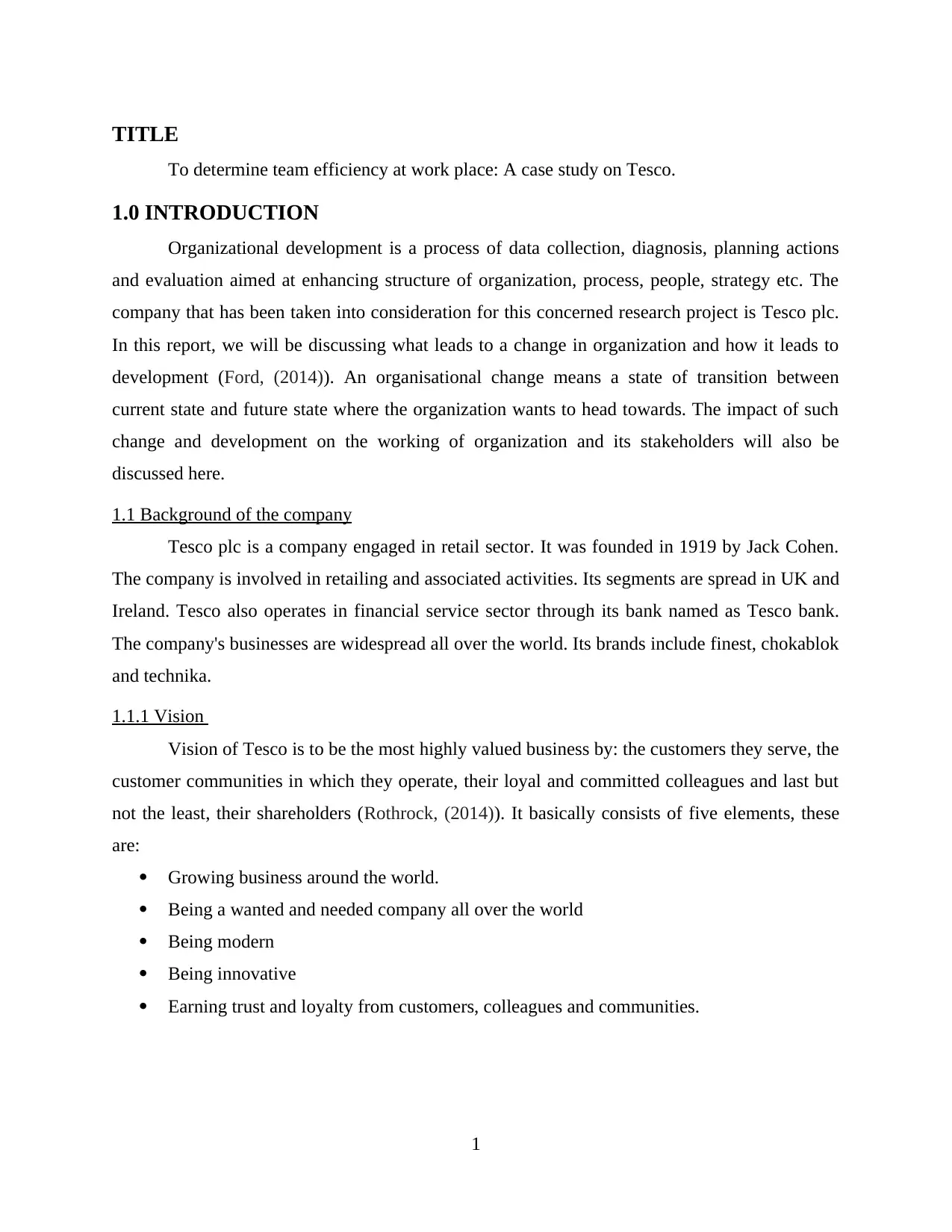
TITLE
To determine team efficiency at work place: A case study on Tesco.
1.0 INTRODUCTION
Organizational development is a process of data collection, diagnosis, planning actions
and evaluation aimed at enhancing structure of organization, process, people, strategy etc. The
company that has been taken into consideration for this concerned research project is Tesco plc.
In this report, we will be discussing what leads to a change in organization and how it leads to
development (Ford, (2014)). An organisational change means a state of transition between
current state and future state where the organization wants to head towards. The impact of such
change and development on the working of organization and its stakeholders will also be
discussed here.
1.1 Background of the company
Tesco plc is a company engaged in retail sector. It was founded in 1919 by Jack Cohen.
The company is involved in retailing and associated activities. Its segments are spread in UK and
Ireland. Tesco also operates in financial service sector through its bank named as Tesco bank.
The company's businesses are widespread all over the world. Its brands include finest, chokablok
and technika.
1.1.1 Vision
Vision of Tesco is to be the most highly valued business by: the customers they serve, the
customer communities in which they operate, their loyal and committed colleagues and last but
not the least, their shareholders (Rothrock, (2014)). It basically consists of five elements, these
are:
Growing business around the world.
Being a wanted and needed company all over the world
Being modern
Being innovative
Earning trust and loyalty from customers, colleagues and communities.
1
To determine team efficiency at work place: A case study on Tesco.
1.0 INTRODUCTION
Organizational development is a process of data collection, diagnosis, planning actions
and evaluation aimed at enhancing structure of organization, process, people, strategy etc. The
company that has been taken into consideration for this concerned research project is Tesco plc.
In this report, we will be discussing what leads to a change in organization and how it leads to
development (Ford, (2014)). An organisational change means a state of transition between
current state and future state where the organization wants to head towards. The impact of such
change and development on the working of organization and its stakeholders will also be
discussed here.
1.1 Background of the company
Tesco plc is a company engaged in retail sector. It was founded in 1919 by Jack Cohen.
The company is involved in retailing and associated activities. Its segments are spread in UK and
Ireland. Tesco also operates in financial service sector through its bank named as Tesco bank.
The company's businesses are widespread all over the world. Its brands include finest, chokablok
and technika.
1.1.1 Vision
Vision of Tesco is to be the most highly valued business by: the customers they serve, the
customer communities in which they operate, their loyal and committed colleagues and last but
not the least, their shareholders (Rothrock, (2014)). It basically consists of five elements, these
are:
Growing business around the world.
Being a wanted and needed company all over the world
Being modern
Being innovative
Earning trust and loyalty from customers, colleagues and communities.
1
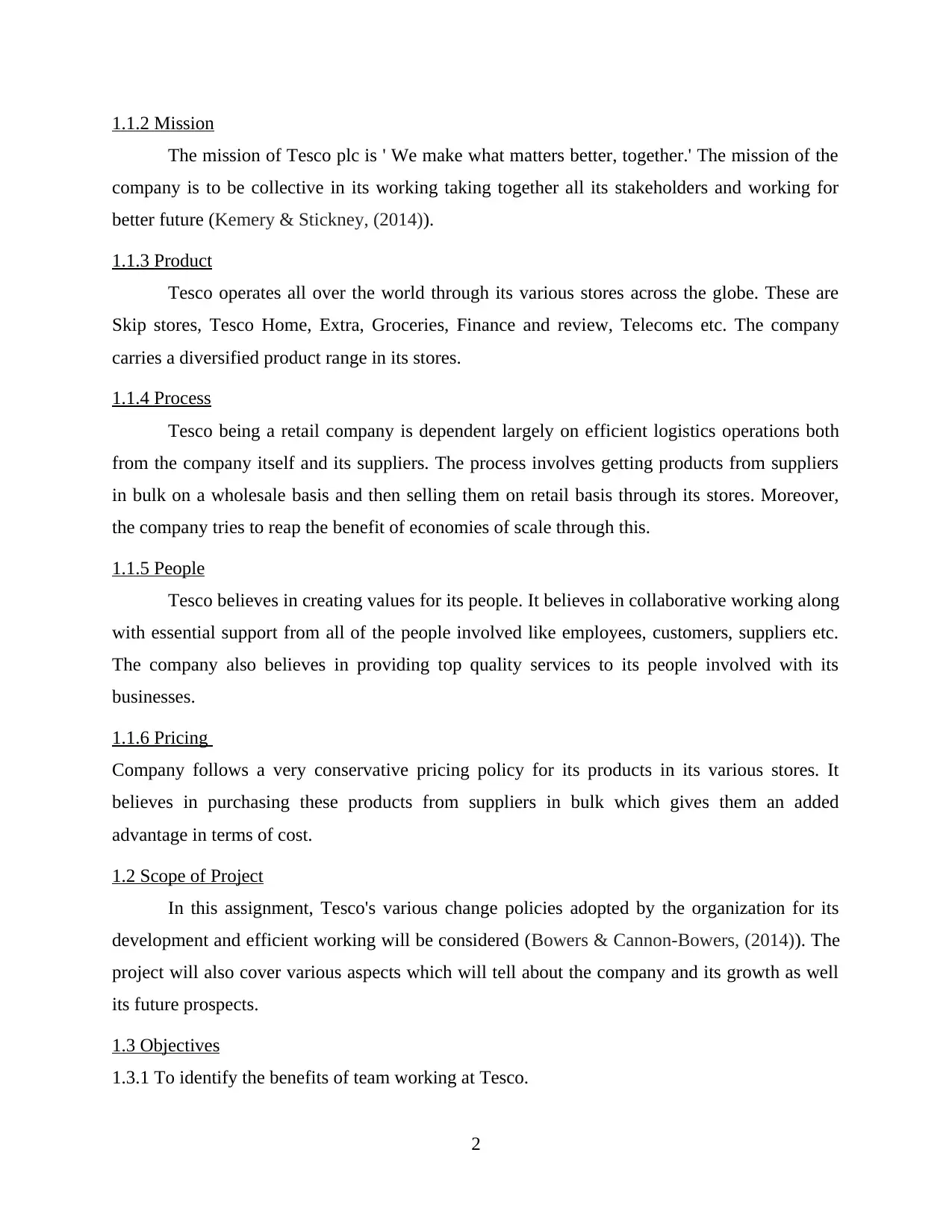
1.1.2 Mission
The mission of Tesco plc is ' We make what matters better, together.' The mission of the
company is to be collective in its working taking together all its stakeholders and working for
better future (Kemery & Stickney, (2014)).
1.1.3 Product
Tesco operates all over the world through its various stores across the globe. These are
Skip stores, Tesco Home, Extra, Groceries, Finance and review, Telecoms etc. The company
carries a diversified product range in its stores.
1.1.4 Process
Tesco being a retail company is dependent largely on efficient logistics operations both
from the company itself and its suppliers. The process involves getting products from suppliers
in bulk on a wholesale basis and then selling them on retail basis through its stores. Moreover,
the company tries to reap the benefit of economies of scale through this.
1.1.5 People
Tesco believes in creating values for its people. It believes in collaborative working along
with essential support from all of the people involved like employees, customers, suppliers etc.
The company also believes in providing top quality services to its people involved with its
businesses.
1.1.6 Pricing
Company follows a very conservative pricing policy for its products in its various stores. It
believes in purchasing these products from suppliers in bulk which gives them an added
advantage in terms of cost.
1.2 Scope of Project
In this assignment, Tesco's various change policies adopted by the organization for its
development and efficient working will be considered (Bowers & Cannon-Bowers, (2014)). The
project will also cover various aspects which will tell about the company and its growth as well
its future prospects.
1.3 Objectives
1.3.1 To identify the benefits of team working at Tesco.
2
The mission of Tesco plc is ' We make what matters better, together.' The mission of the
company is to be collective in its working taking together all its stakeholders and working for
better future (Kemery & Stickney, (2014)).
1.1.3 Product
Tesco operates all over the world through its various stores across the globe. These are
Skip stores, Tesco Home, Extra, Groceries, Finance and review, Telecoms etc. The company
carries a diversified product range in its stores.
1.1.4 Process
Tesco being a retail company is dependent largely on efficient logistics operations both
from the company itself and its suppliers. The process involves getting products from suppliers
in bulk on a wholesale basis and then selling them on retail basis through its stores. Moreover,
the company tries to reap the benefit of economies of scale through this.
1.1.5 People
Tesco believes in creating values for its people. It believes in collaborative working along
with essential support from all of the people involved like employees, customers, suppliers etc.
The company also believes in providing top quality services to its people involved with its
businesses.
1.1.6 Pricing
Company follows a very conservative pricing policy for its products in its various stores. It
believes in purchasing these products from suppliers in bulk which gives them an added
advantage in terms of cost.
1.2 Scope of Project
In this assignment, Tesco's various change policies adopted by the organization for its
development and efficient working will be considered (Bowers & Cannon-Bowers, (2014)). The
project will also cover various aspects which will tell about the company and its growth as well
its future prospects.
1.3 Objectives
1.3.1 To identify the benefits of team working at Tesco.
2
Secure Best Marks with AI Grader
Need help grading? Try our AI Grader for instant feedback on your assignments.
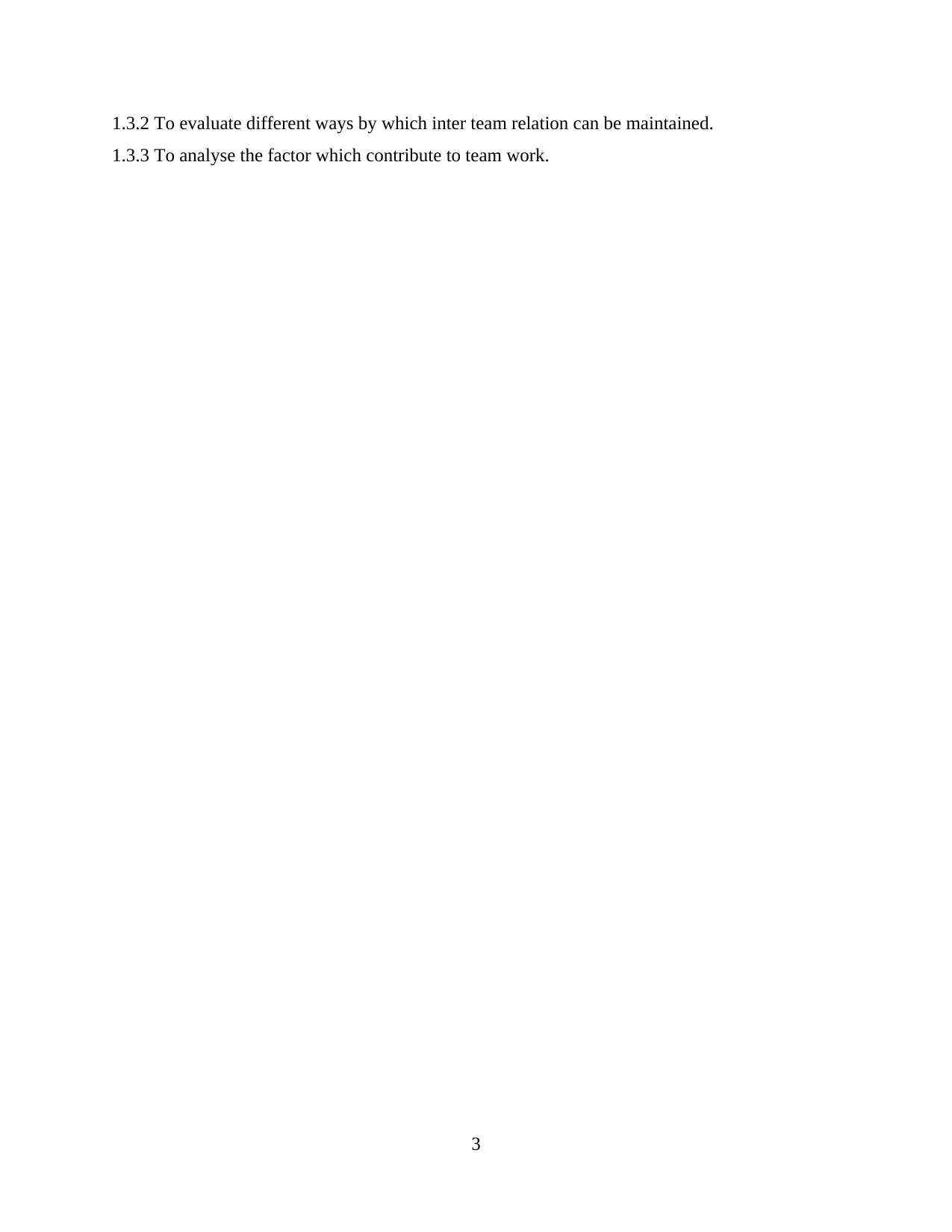
1.3.2 To evaluate different ways by which inter team relation can be maintained.
1.3.3 To analyse the factor which contribute to team work.
3
1.3.3 To analyse the factor which contribute to team work.
3
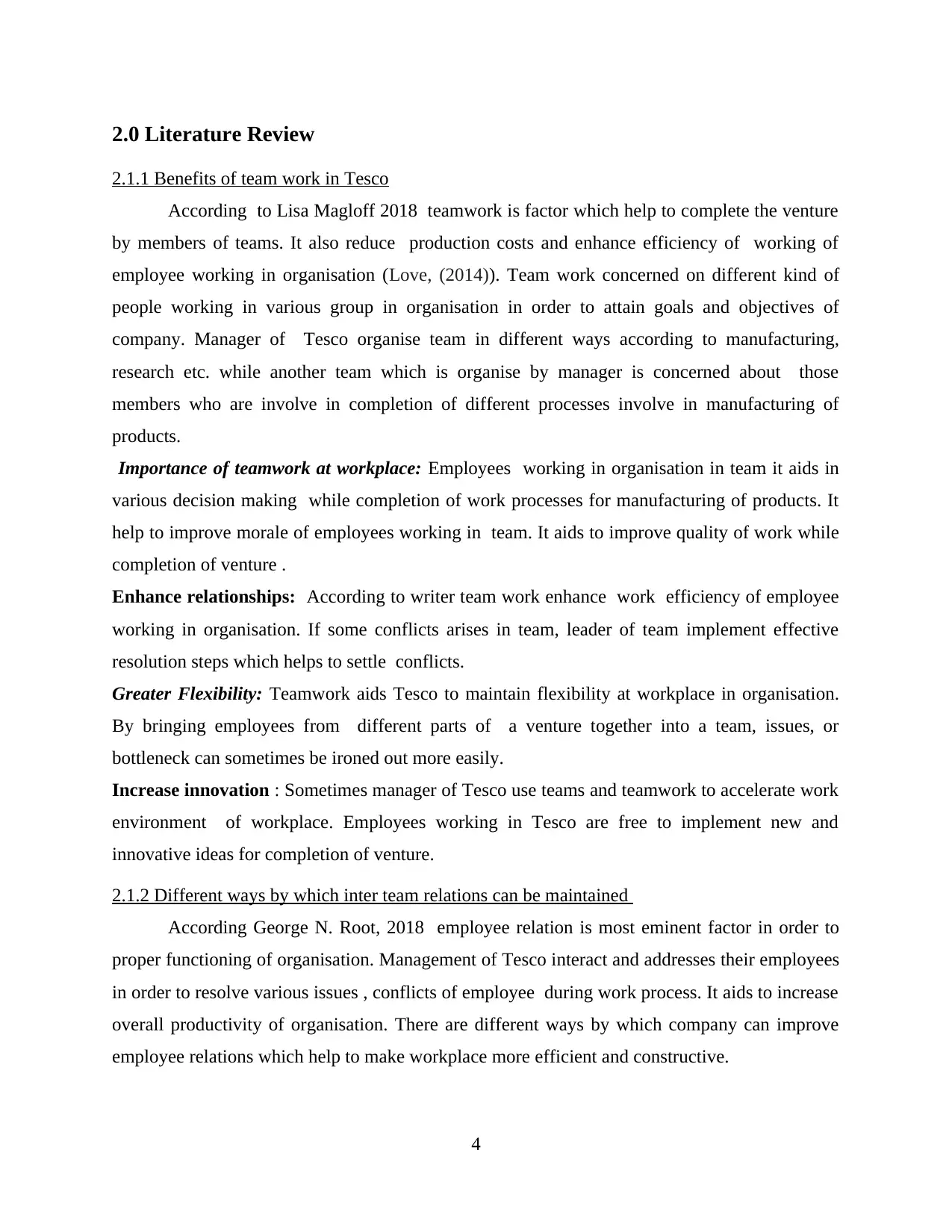
2.0 Literature Review
2.1.1 Benefits of team work in Tesco
According to Lisa Magloff 2018 teamwork is factor which help to complete the venture
by members of teams. It also reduce production costs and enhance efficiency of working of
employee working in organisation (Love, (2014)). Team work concerned on different kind of
people working in various group in organisation in order to attain goals and objectives of
company. Manager of Tesco organise team in different ways according to manufacturing,
research etc. while another team which is organise by manager is concerned about those
members who are involve in completion of different processes involve in manufacturing of
products.
Importance of teamwork at workplace: Employees working in organisation in team it aids in
various decision making while completion of work processes for manufacturing of products. It
help to improve morale of employees working in team. It aids to improve quality of work while
completion of venture .
Enhance relationships: According to writer team work enhance work efficiency of employee
working in organisation. If some conflicts arises in team, leader of team implement effective
resolution steps which helps to settle conflicts.
Greater Flexibility: Teamwork aids Tesco to maintain flexibility at workplace in organisation.
By bringing employees from different parts of a venture together into a team, issues, or
bottleneck can sometimes be ironed out more easily.
Increase innovation : Sometimes manager of Tesco use teams and teamwork to accelerate work
environment of workplace. Employees working in Tesco are free to implement new and
innovative ideas for completion of venture.
2.1.2 Different ways by which inter team relations can be maintained
According George N. Root, 2018 employee relation is most eminent factor in order to
proper functioning of organisation. Management of Tesco interact and addresses their employees
in order to resolve various issues , conflicts of employee during work process. It aids to increase
overall productivity of organisation. There are different ways by which company can improve
employee relations which help to make workplace more efficient and constructive.
4
2.1.1 Benefits of team work in Tesco
According to Lisa Magloff 2018 teamwork is factor which help to complete the venture
by members of teams. It also reduce production costs and enhance efficiency of working of
employee working in organisation (Love, (2014)). Team work concerned on different kind of
people working in various group in organisation in order to attain goals and objectives of
company. Manager of Tesco organise team in different ways according to manufacturing,
research etc. while another team which is organise by manager is concerned about those
members who are involve in completion of different processes involve in manufacturing of
products.
Importance of teamwork at workplace: Employees working in organisation in team it aids in
various decision making while completion of work processes for manufacturing of products. It
help to improve morale of employees working in team. It aids to improve quality of work while
completion of venture .
Enhance relationships: According to writer team work enhance work efficiency of employee
working in organisation. If some conflicts arises in team, leader of team implement effective
resolution steps which helps to settle conflicts.
Greater Flexibility: Teamwork aids Tesco to maintain flexibility at workplace in organisation.
By bringing employees from different parts of a venture together into a team, issues, or
bottleneck can sometimes be ironed out more easily.
Increase innovation : Sometimes manager of Tesco use teams and teamwork to accelerate work
environment of workplace. Employees working in Tesco are free to implement new and
innovative ideas for completion of venture.
2.1.2 Different ways by which inter team relations can be maintained
According George N. Root, 2018 employee relation is most eminent factor in order to
proper functioning of organisation. Management of Tesco interact and addresses their employees
in order to resolve various issues , conflicts of employee during work process. It aids to increase
overall productivity of organisation. There are different ways by which company can improve
employee relations which help to make workplace more efficient and constructive.
4
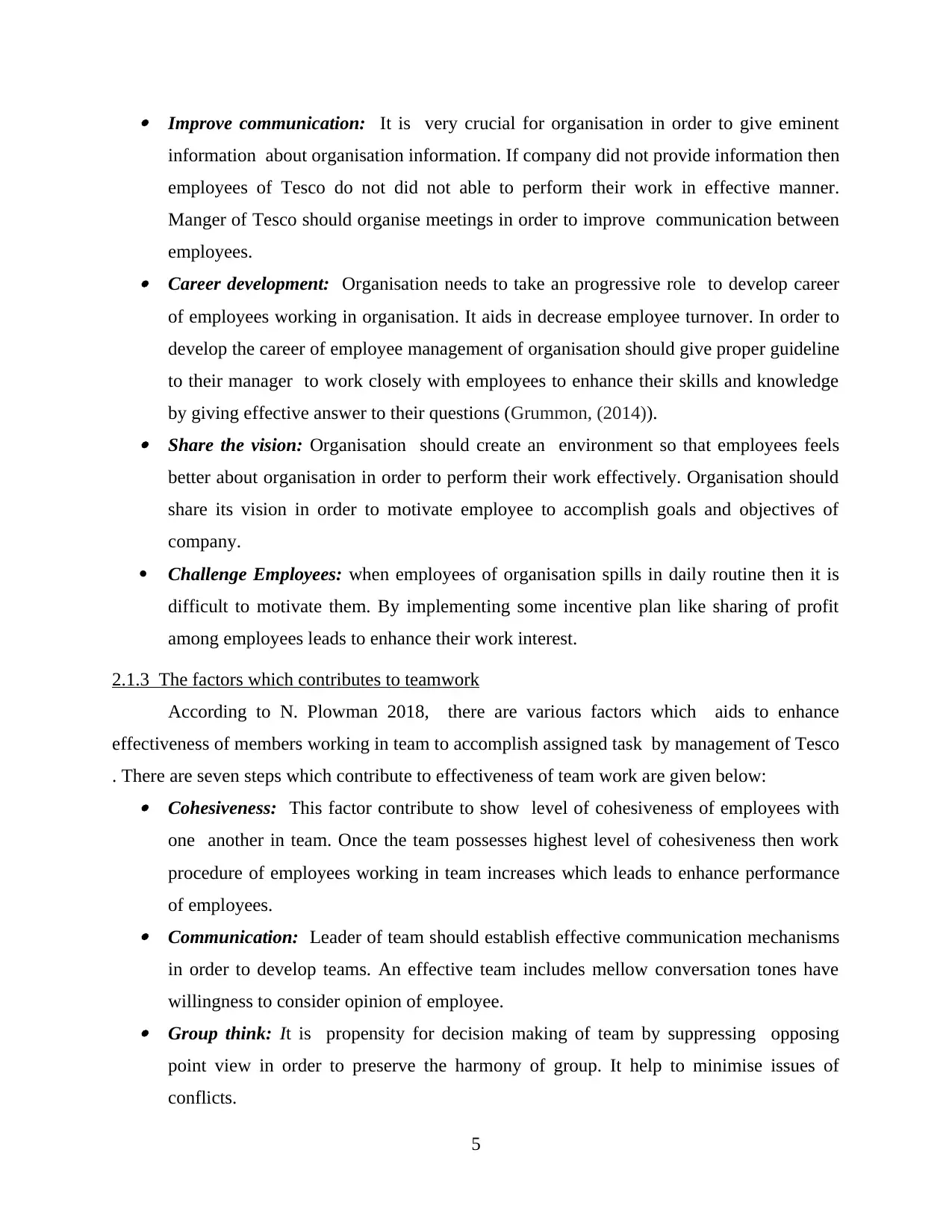
Improve communication: It is very crucial for organisation in order to give eminent
information about organisation information. If company did not provide information then
employees of Tesco do not did not able to perform their work in effective manner.
Manger of Tesco should organise meetings in order to improve communication between
employees. Career development: Organisation needs to take an progressive role to develop career
of employees working in organisation. It aids in decrease employee turnover. In order to
develop the career of employee management of organisation should give proper guideline
to their manager to work closely with employees to enhance their skills and knowledge
by giving effective answer to their questions (Grummon, (2014)). Share the vision: Organisation should create an environment so that employees feels
better about organisation in order to perform their work effectively. Organisation should
share its vision in order to motivate employee to accomplish goals and objectives of
company.
Challenge Employees: when employees of organisation spills in daily routine then it is
difficult to motivate them. By implementing some incentive plan like sharing of profit
among employees leads to enhance their work interest.
2.1.3 The factors which contributes to teamwork
According to N. Plowman 2018, there are various factors which aids to enhance
effectiveness of members working in team to accomplish assigned task by management of Tesco
. There are seven steps which contribute to effectiveness of team work are given below: Cohesiveness: This factor contribute to show level of cohesiveness of employees with
one another in team. Once the team possesses highest level of cohesiveness then work
procedure of employees working in team increases which leads to enhance performance
of employees. Communication: Leader of team should establish effective communication mechanisms
in order to develop teams. An effective team includes mellow conversation tones have
willingness to consider opinion of employee. Group think: It is propensity for decision making of team by suppressing opposing
point view in order to preserve the harmony of group. It help to minimise issues of
conflicts.
5
information about organisation information. If company did not provide information then
employees of Tesco do not did not able to perform their work in effective manner.
Manger of Tesco should organise meetings in order to improve communication between
employees. Career development: Organisation needs to take an progressive role to develop career
of employees working in organisation. It aids in decrease employee turnover. In order to
develop the career of employee management of organisation should give proper guideline
to their manager to work closely with employees to enhance their skills and knowledge
by giving effective answer to their questions (Grummon, (2014)). Share the vision: Organisation should create an environment so that employees feels
better about organisation in order to perform their work effectively. Organisation should
share its vision in order to motivate employee to accomplish goals and objectives of
company.
Challenge Employees: when employees of organisation spills in daily routine then it is
difficult to motivate them. By implementing some incentive plan like sharing of profit
among employees leads to enhance their work interest.
2.1.3 The factors which contributes to teamwork
According to N. Plowman 2018, there are various factors which aids to enhance
effectiveness of members working in team to accomplish assigned task by management of Tesco
. There are seven steps which contribute to effectiveness of team work are given below: Cohesiveness: This factor contribute to show level of cohesiveness of employees with
one another in team. Once the team possesses highest level of cohesiveness then work
procedure of employees working in team increases which leads to enhance performance
of employees. Communication: Leader of team should establish effective communication mechanisms
in order to develop teams. An effective team includes mellow conversation tones have
willingness to consider opinion of employee. Group think: It is propensity for decision making of team by suppressing opposing
point view in order to preserve the harmony of group. It help to minimise issues of
conflicts.
5
Paraphrase This Document
Need a fresh take? Get an instant paraphrase of this document with our AI Paraphraser
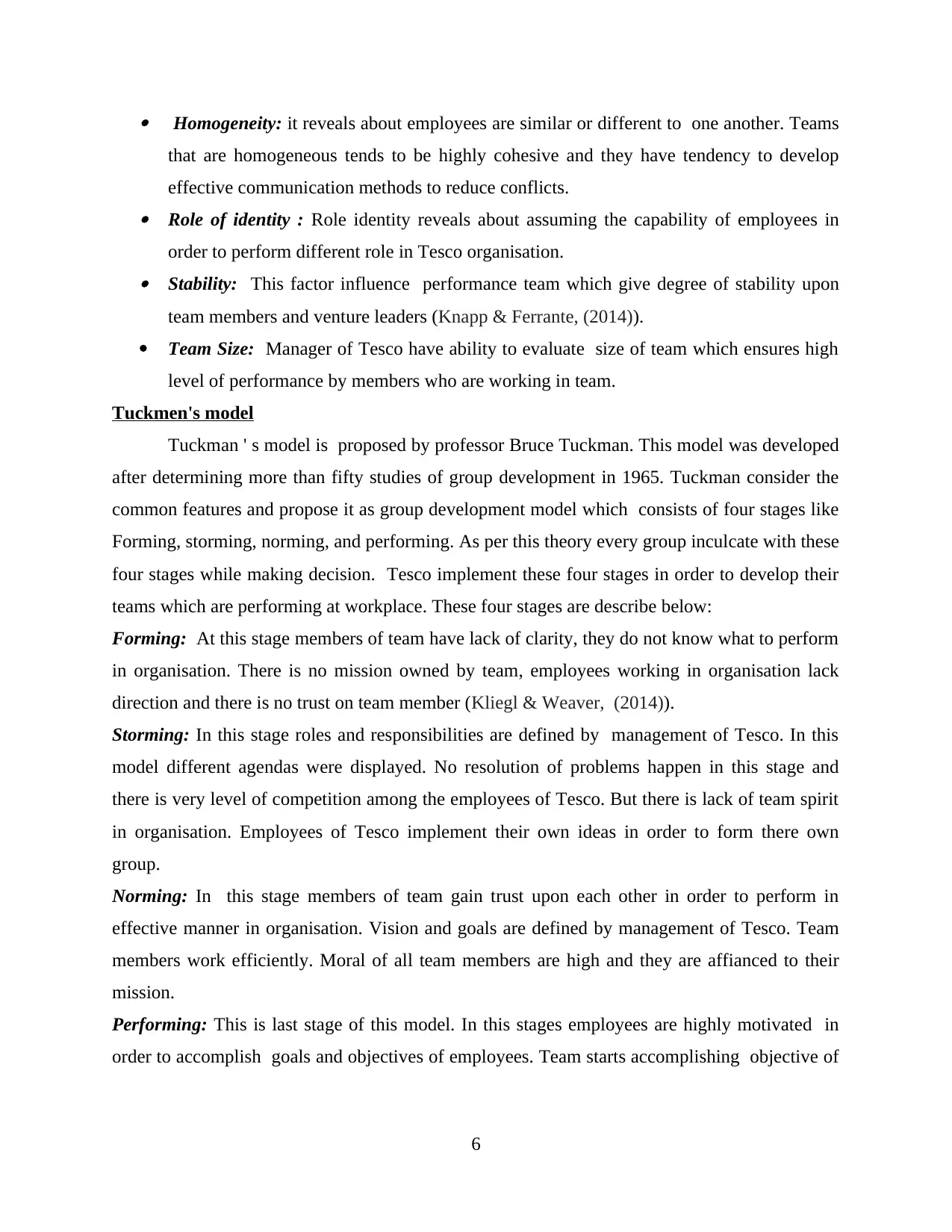
Homogeneity: it reveals about employees are similar or different to one another. Teams
that are homogeneous tends to be highly cohesive and they have tendency to develop
effective communication methods to reduce conflicts. Role of identity : Role identity reveals about assuming the capability of employees in
order to perform different role in Tesco organisation. Stability: This factor influence performance team which give degree of stability upon
team members and venture leaders (Knapp & Ferrante, (2014)).
Team Size: Manager of Tesco have ability to evaluate size of team which ensures high
level of performance by members who are working in team.
Tuckmen's model
Tuckman ' s model is proposed by professor Bruce Tuckman. This model was developed
after determining more than fifty studies of group development in 1965. Tuckman consider the
common features and propose it as group development model which consists of four stages like
Forming, storming, norming, and performing. As per this theory every group inculcate with these
four stages while making decision. Tesco implement these four stages in order to develop their
teams which are performing at workplace. These four stages are describe below:
Forming: At this stage members of team have lack of clarity, they do not know what to perform
in organisation. There is no mission owned by team, employees working in organisation lack
direction and there is no trust on team member (Kliegl & Weaver, (2014)).
Storming: In this stage roles and responsibilities are defined by management of Tesco. In this
model different agendas were displayed. No resolution of problems happen in this stage and
there is very level of competition among the employees of Tesco. But there is lack of team spirit
in organisation. Employees of Tesco implement their own ideas in order to form there own
group.
Norming: In this stage members of team gain trust upon each other in order to perform in
effective manner in organisation. Vision and goals are defined by management of Tesco. Team
members work efficiently. Moral of all team members are high and they are affianced to their
mission.
Performing: This is last stage of this model. In this stages employees are highly motivated in
order to accomplish goals and objectives of employees. Team starts accomplishing objective of
6
that are homogeneous tends to be highly cohesive and they have tendency to develop
effective communication methods to reduce conflicts. Role of identity : Role identity reveals about assuming the capability of employees in
order to perform different role in Tesco organisation. Stability: This factor influence performance team which give degree of stability upon
team members and venture leaders (Knapp & Ferrante, (2014)).
Team Size: Manager of Tesco have ability to evaluate size of team which ensures high
level of performance by members who are working in team.
Tuckmen's model
Tuckman ' s model is proposed by professor Bruce Tuckman. This model was developed
after determining more than fifty studies of group development in 1965. Tuckman consider the
common features and propose it as group development model which consists of four stages like
Forming, storming, norming, and performing. As per this theory every group inculcate with these
four stages while making decision. Tesco implement these four stages in order to develop their
teams which are performing at workplace. These four stages are describe below:
Forming: At this stage members of team have lack of clarity, they do not know what to perform
in organisation. There is no mission owned by team, employees working in organisation lack
direction and there is no trust on team member (Kliegl & Weaver, (2014)).
Storming: In this stage roles and responsibilities are defined by management of Tesco. In this
model different agendas were displayed. No resolution of problems happen in this stage and
there is very level of competition among the employees of Tesco. But there is lack of team spirit
in organisation. Employees of Tesco implement their own ideas in order to form there own
group.
Norming: In this stage members of team gain trust upon each other in order to perform in
effective manner in organisation. Vision and goals are defined by management of Tesco. Team
members work efficiently. Moral of all team members are high and they are affianced to their
mission.
Performing: This is last stage of this model. In this stages employees are highly motivated in
order to accomplish goals and objectives of employees. Team starts accomplishing objective of
6
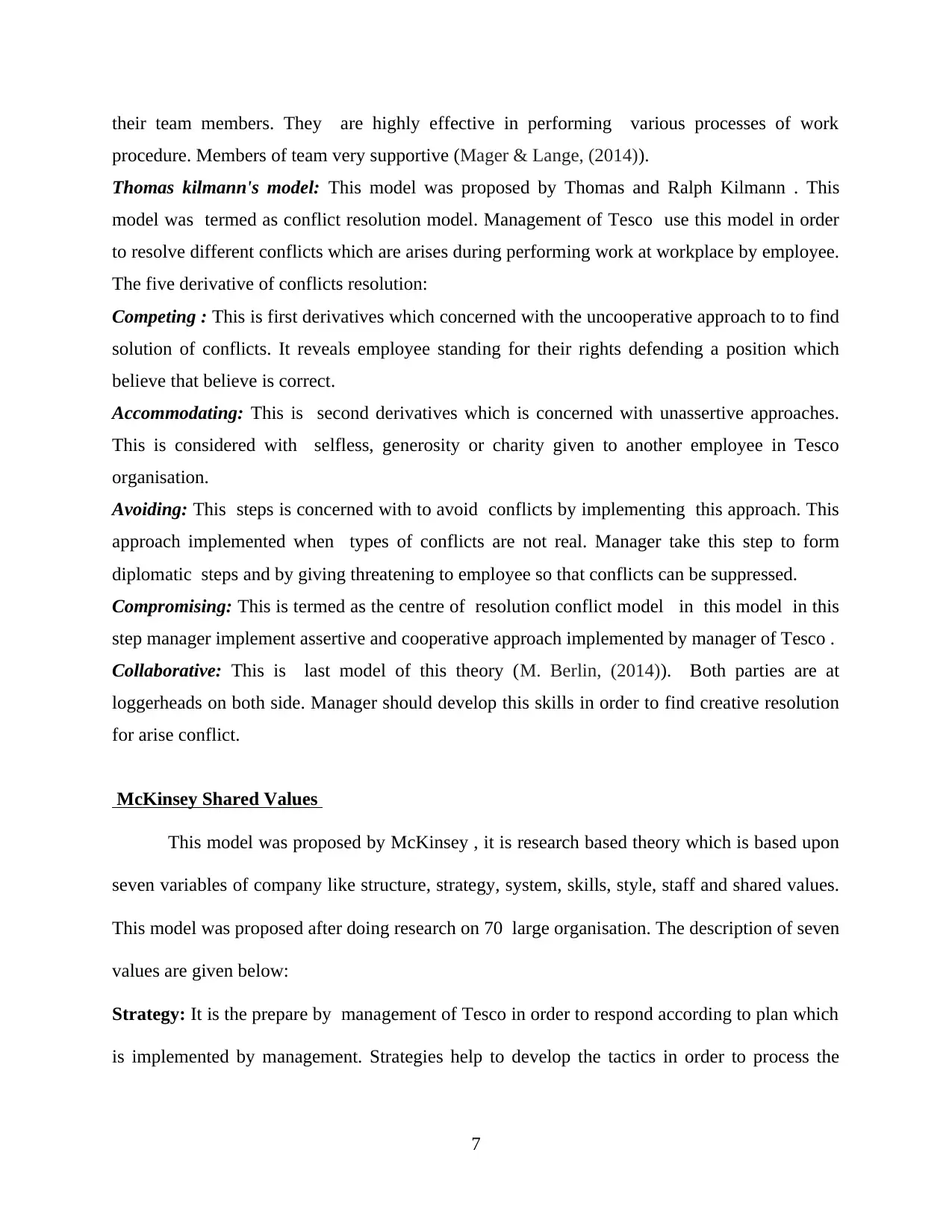
their team members. They are highly effective in performing various processes of work
procedure. Members of team very supportive (Mager & Lange, (2014)).
Thomas kilmann's model: This model was proposed by Thomas and Ralph Kilmann . This
model was termed as conflict resolution model. Management of Tesco use this model in order
to resolve different conflicts which are arises during performing work at workplace by employee.
The five derivative of conflicts resolution:
Competing : This is first derivatives which concerned with the uncooperative approach to to find
solution of conflicts. It reveals employee standing for their rights defending a position which
believe that believe is correct.
Accommodating: This is second derivatives which is concerned with unassertive approaches.
This is considered with selfless, generosity or charity given to another employee in Tesco
organisation.
Avoiding: This steps is concerned with to avoid conflicts by implementing this approach. This
approach implemented when types of conflicts are not real. Manager take this step to form
diplomatic steps and by giving threatening to employee so that conflicts can be suppressed.
Compromising: This is termed as the centre of resolution conflict model in this model in this
step manager implement assertive and cooperative approach implemented by manager of Tesco .
Collaborative: This is last model of this theory (M. Berlin, (2014)). Both parties are at
loggerheads on both side. Manager should develop this skills in order to find creative resolution
for arise conflict.
McKinsey Shared Values
This model was proposed by McKinsey , it is research based theory which is based upon
seven variables of company like structure, strategy, system, skills, style, staff and shared values.
This model was proposed after doing research on 70 large organisation. The description of seven
values are given below:
Strategy: It is the prepare by management of Tesco in order to respond according to plan which
is implemented by management. Strategies help to develop the tactics in order to process the
7
procedure. Members of team very supportive (Mager & Lange, (2014)).
Thomas kilmann's model: This model was proposed by Thomas and Ralph Kilmann . This
model was termed as conflict resolution model. Management of Tesco use this model in order
to resolve different conflicts which are arises during performing work at workplace by employee.
The five derivative of conflicts resolution:
Competing : This is first derivatives which concerned with the uncooperative approach to to find
solution of conflicts. It reveals employee standing for their rights defending a position which
believe that believe is correct.
Accommodating: This is second derivatives which is concerned with unassertive approaches.
This is considered with selfless, generosity or charity given to another employee in Tesco
organisation.
Avoiding: This steps is concerned with to avoid conflicts by implementing this approach. This
approach implemented when types of conflicts are not real. Manager take this step to form
diplomatic steps and by giving threatening to employee so that conflicts can be suppressed.
Compromising: This is termed as the centre of resolution conflict model in this model in this
step manager implement assertive and cooperative approach implemented by manager of Tesco .
Collaborative: This is last model of this theory (M. Berlin, (2014)). Both parties are at
loggerheads on both side. Manager should develop this skills in order to find creative resolution
for arise conflict.
McKinsey Shared Values
This model was proposed by McKinsey , it is research based theory which is based upon
seven variables of company like structure, strategy, system, skills, style, staff and shared values.
This model was proposed after doing research on 70 large organisation. The description of seven
values are given below:
Strategy: It is the prepare by management of Tesco in order to respond according to plan which
is implemented by management. Strategies help to develop the tactics in order to process the
7
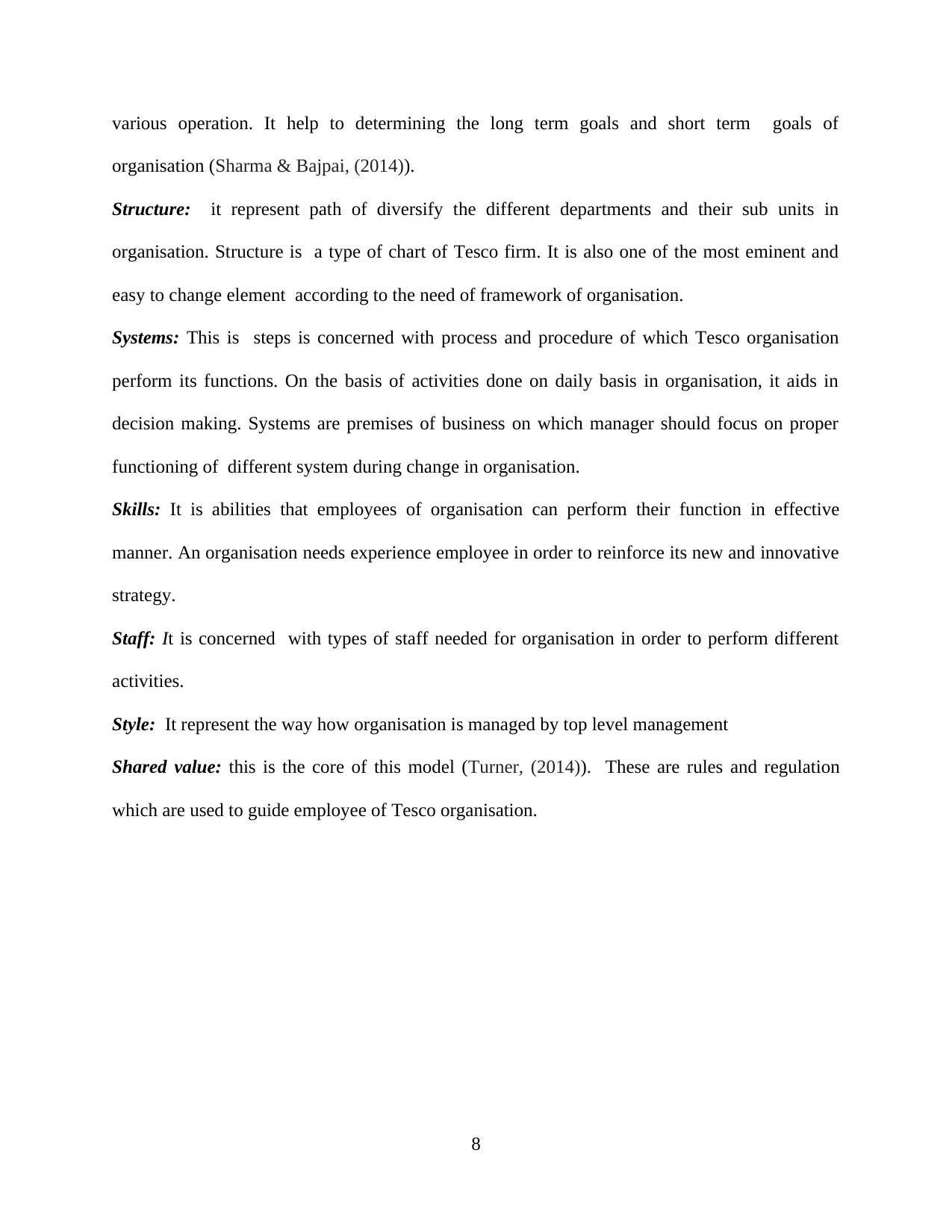
various operation. It help to determining the long term goals and short term goals of
organisation (Sharma & Bajpai, (2014)).
Structure: it represent path of diversify the different departments and their sub units in
organisation. Structure is a type of chart of Tesco firm. It is also one of the most eminent and
easy to change element according to the need of framework of organisation.
Systems: This is steps is concerned with process and procedure of which Tesco organisation
perform its functions. On the basis of activities done on daily basis in organisation, it aids in
decision making. Systems are premises of business on which manager should focus on proper
functioning of different system during change in organisation.
Skills: It is abilities that employees of organisation can perform their function in effective
manner. An organisation needs experience employee in order to reinforce its new and innovative
strategy.
Staff: It is concerned with types of staff needed for organisation in order to perform different
activities.
Style: It represent the way how organisation is managed by top level management
Shared value: this is the core of this model (Turner, (2014)). These are rules and regulation
which are used to guide employee of Tesco organisation.
8
organisation (Sharma & Bajpai, (2014)).
Structure: it represent path of diversify the different departments and their sub units in
organisation. Structure is a type of chart of Tesco firm. It is also one of the most eminent and
easy to change element according to the need of framework of organisation.
Systems: This is steps is concerned with process and procedure of which Tesco organisation
perform its functions. On the basis of activities done on daily basis in organisation, it aids in
decision making. Systems are premises of business on which manager should focus on proper
functioning of different system during change in organisation.
Skills: It is abilities that employees of organisation can perform their function in effective
manner. An organisation needs experience employee in order to reinforce its new and innovative
strategy.
Staff: It is concerned with types of staff needed for organisation in order to perform different
activities.
Style: It represent the way how organisation is managed by top level management
Shared value: this is the core of this model (Turner, (2014)). These are rules and regulation
which are used to guide employee of Tesco organisation.
8
Secure Best Marks with AI Grader
Need help grading? Try our AI Grader for instant feedback on your assignments.
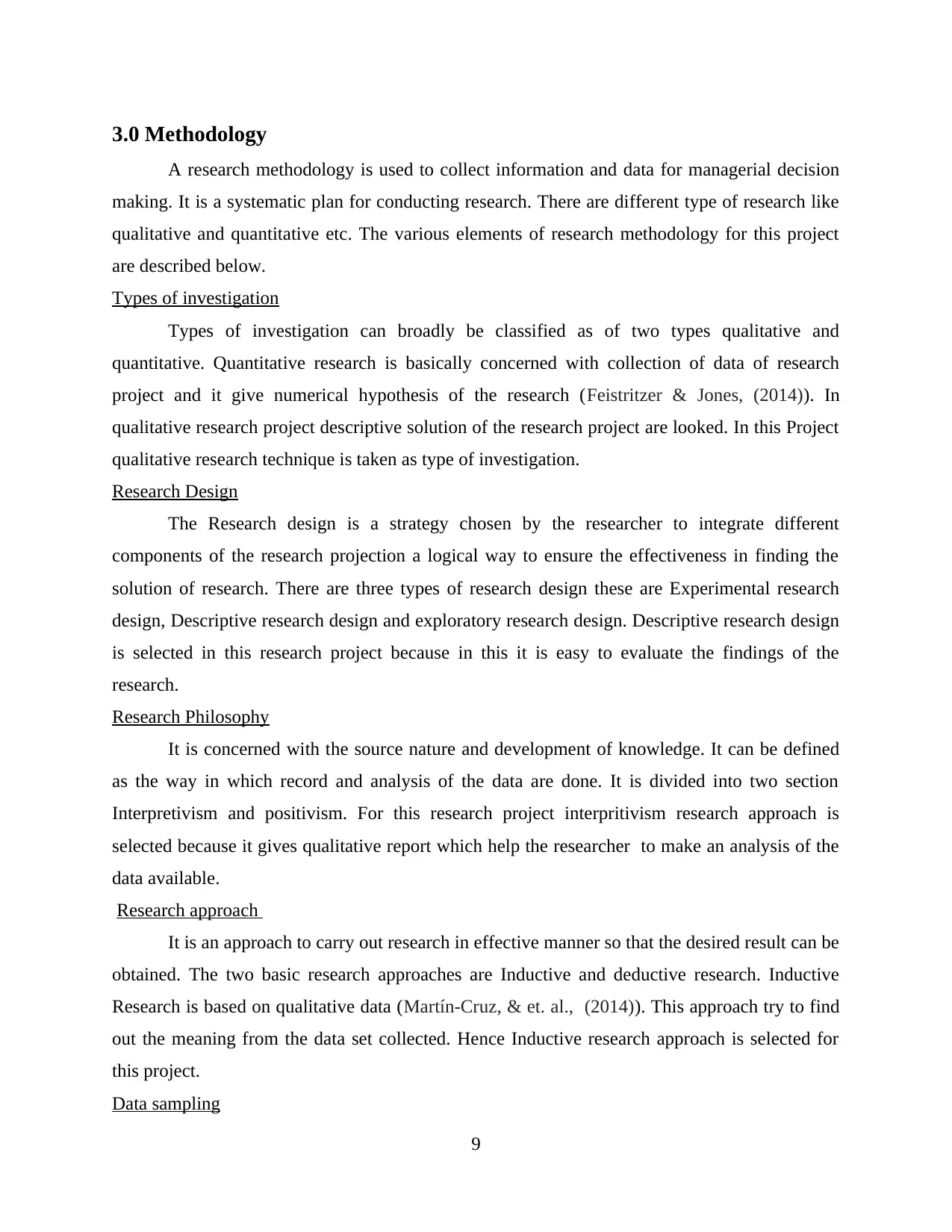
3.0 Methodology
A research methodology is used to collect information and data for managerial decision
making. It is a systematic plan for conducting research. There are different type of research like
qualitative and quantitative etc. The various elements of research methodology for this project
are described below.
Types of investigation
Types of investigation can broadly be classified as of two types qualitative and
quantitative. Quantitative research is basically concerned with collection of data of research
project and it give numerical hypothesis of the research (Feistritzer & Jones, (2014)). In
qualitative research project descriptive solution of the research project are looked. In this Project
qualitative research technique is taken as type of investigation.
Research Design
The Research design is a strategy chosen by the researcher to integrate different
components of the research projection a logical way to ensure the effectiveness in finding the
solution of research. There are three types of research design these are Experimental research
design, Descriptive research design and exploratory research design. Descriptive research design
is selected in this research project because in this it is easy to evaluate the findings of the
research.
Research Philosophy
It is concerned with the source nature and development of knowledge. It can be defined
as the way in which record and analysis of the data are done. It is divided into two section
Interpretivism and positivism. For this research project interpritivism research approach is
selected because it gives qualitative report which help the researcher to make an analysis of the
data available.
Research approach
It is an approach to carry out research in effective manner so that the desired result can be
obtained. The two basic research approaches are Inductive and deductive research. Inductive
Research is based on qualitative data (Martín‐Cruz, & et. al., (2014)). This approach try to find
out the meaning from the data set collected. Hence Inductive research approach is selected for
this project.
Data sampling
9
A research methodology is used to collect information and data for managerial decision
making. It is a systematic plan for conducting research. There are different type of research like
qualitative and quantitative etc. The various elements of research methodology for this project
are described below.
Types of investigation
Types of investigation can broadly be classified as of two types qualitative and
quantitative. Quantitative research is basically concerned with collection of data of research
project and it give numerical hypothesis of the research (Feistritzer & Jones, (2014)). In
qualitative research project descriptive solution of the research project are looked. In this Project
qualitative research technique is taken as type of investigation.
Research Design
The Research design is a strategy chosen by the researcher to integrate different
components of the research projection a logical way to ensure the effectiveness in finding the
solution of research. There are three types of research design these are Experimental research
design, Descriptive research design and exploratory research design. Descriptive research design
is selected in this research project because in this it is easy to evaluate the findings of the
research.
Research Philosophy
It is concerned with the source nature and development of knowledge. It can be defined
as the way in which record and analysis of the data are done. It is divided into two section
Interpretivism and positivism. For this research project interpritivism research approach is
selected because it gives qualitative report which help the researcher to make an analysis of the
data available.
Research approach
It is an approach to carry out research in effective manner so that the desired result can be
obtained. The two basic research approaches are Inductive and deductive research. Inductive
Research is based on qualitative data (Martín‐Cruz, & et. al., (2014)). This approach try to find
out the meaning from the data set collected. Hence Inductive research approach is selected for
this project.
Data sampling
9
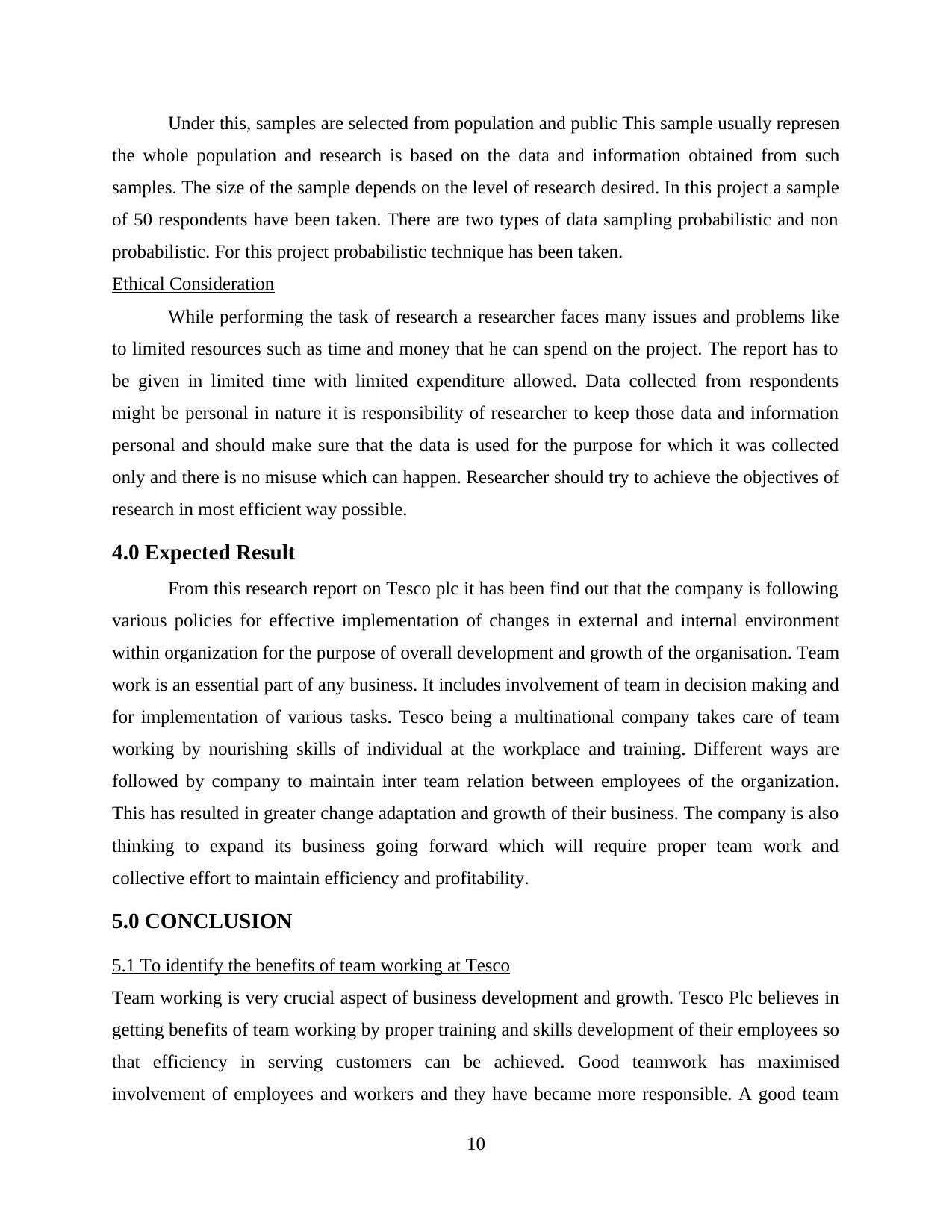
Under this, samples are selected from population and public This sample usually represen
the whole population and research is based on the data and information obtained from such
samples. The size of the sample depends on the level of research desired. In this project a sample
of 50 respondents have been taken. There are two types of data sampling probabilistic and non
probabilistic. For this project probabilistic technique has been taken.
Ethical Consideration
While performing the task of research a researcher faces many issues and problems like
to limited resources such as time and money that he can spend on the project. The report has to
be given in limited time with limited expenditure allowed. Data collected from respondents
might be personal in nature it is responsibility of researcher to keep those data and information
personal and should make sure that the data is used for the purpose for which it was collected
only and there is no misuse which can happen. Researcher should try to achieve the objectives of
research in most efficient way possible.
4.0 Expected Result
From this research report on Tesco plc it has been find out that the company is following
various policies for effective implementation of changes in external and internal environment
within organization for the purpose of overall development and growth of the organisation. Team
work is an essential part of any business. It includes involvement of team in decision making and
for implementation of various tasks. Tesco being a multinational company takes care of team
working by nourishing skills of individual at the workplace and training. Different ways are
followed by company to maintain inter team relation between employees of the organization.
This has resulted in greater change adaptation and growth of their business. The company is also
thinking to expand its business going forward which will require proper team work and
collective effort to maintain efficiency and profitability.
5.0 CONCLUSION
5.1 To identify the benefits of team working at Tesco
Team working is very crucial aspect of business development and growth. Tesco Plc believes in
getting benefits of team working by proper training and skills development of their employees so
that efficiency in serving customers can be achieved. Good teamwork has maximised
involvement of employees and workers and they have became more responsible. A good team
10
the whole population and research is based on the data and information obtained from such
samples. The size of the sample depends on the level of research desired. In this project a sample
of 50 respondents have been taken. There are two types of data sampling probabilistic and non
probabilistic. For this project probabilistic technique has been taken.
Ethical Consideration
While performing the task of research a researcher faces many issues and problems like
to limited resources such as time and money that he can spend on the project. The report has to
be given in limited time with limited expenditure allowed. Data collected from respondents
might be personal in nature it is responsibility of researcher to keep those data and information
personal and should make sure that the data is used for the purpose for which it was collected
only and there is no misuse which can happen. Researcher should try to achieve the objectives of
research in most efficient way possible.
4.0 Expected Result
From this research report on Tesco plc it has been find out that the company is following
various policies for effective implementation of changes in external and internal environment
within organization for the purpose of overall development and growth of the organisation. Team
work is an essential part of any business. It includes involvement of team in decision making and
for implementation of various tasks. Tesco being a multinational company takes care of team
working by nourishing skills of individual at the workplace and training. Different ways are
followed by company to maintain inter team relation between employees of the organization.
This has resulted in greater change adaptation and growth of their business. The company is also
thinking to expand its business going forward which will require proper team work and
collective effort to maintain efficiency and profitability.
5.0 CONCLUSION
5.1 To identify the benefits of team working at Tesco
Team working is very crucial aspect of business development and growth. Tesco Plc believes in
getting benefits of team working by proper training and skills development of their employees so
that efficiency in serving customers can be achieved. Good teamwork has maximised
involvement of employees and workers and they have became more responsible. A good team
10
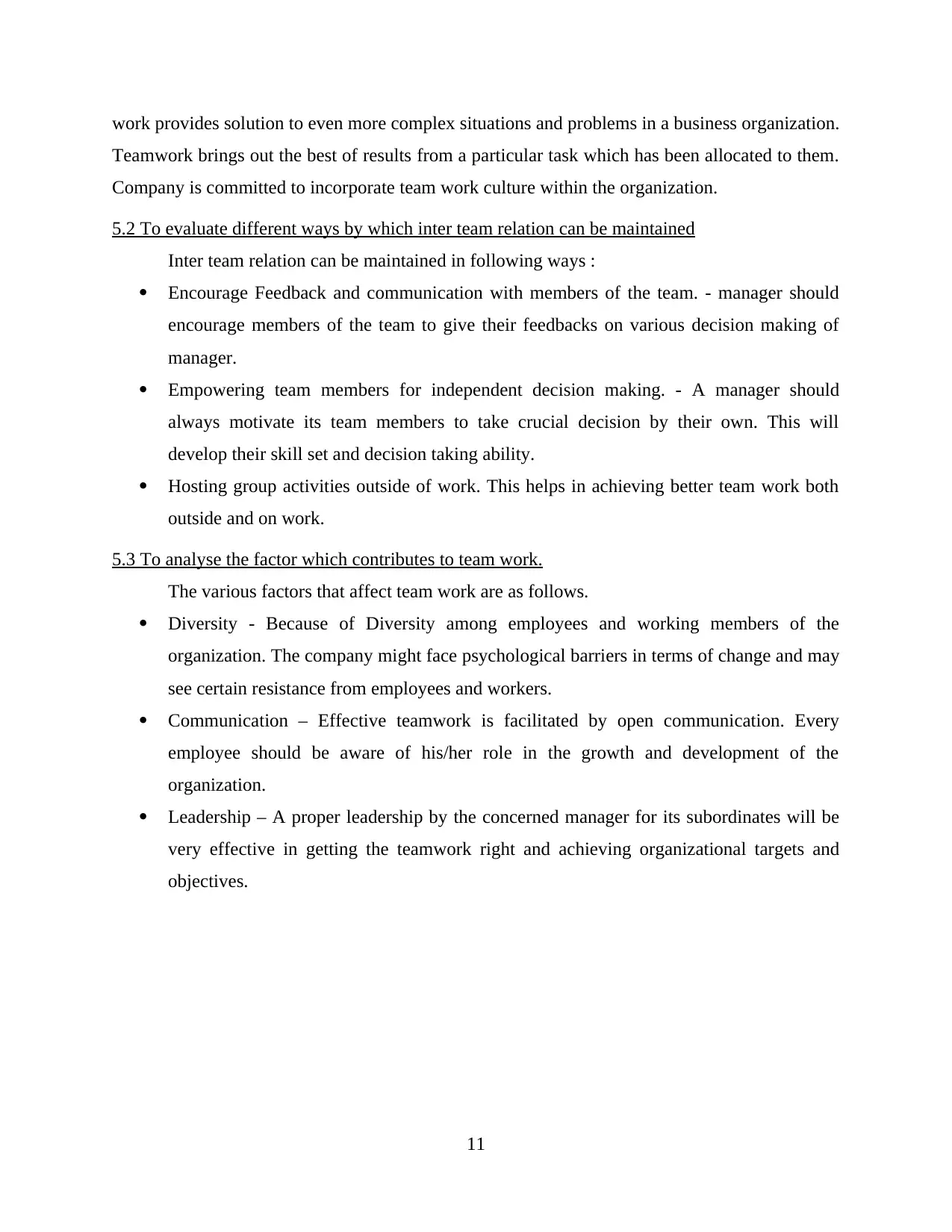
work provides solution to even more complex situations and problems in a business organization.
Teamwork brings out the best of results from a particular task which has been allocated to them.
Company is committed to incorporate team work culture within the organization.
5.2 To evaluate different ways by which inter team relation can be maintained
Inter team relation can be maintained in following ways :
Encourage Feedback and communication with members of the team. - manager should
encourage members of the team to give their feedbacks on various decision making of
manager.
Empowering team members for independent decision making. - A manager should
always motivate its team members to take crucial decision by their own. This will
develop their skill set and decision taking ability.
Hosting group activities outside of work. This helps in achieving better team work both
outside and on work.
5.3 To analyse the factor which contributes to team work.
The various factors that affect team work are as follows.
Diversity - Because of Diversity among employees and working members of the
organization. The company might face psychological barriers in terms of change and may
see certain resistance from employees and workers.
Communication – Effective teamwork is facilitated by open communication. Every
employee should be aware of his/her role in the growth and development of the
organization.
Leadership – A proper leadership by the concerned manager for its subordinates will be
very effective in getting the teamwork right and achieving organizational targets and
objectives.
11
Teamwork brings out the best of results from a particular task which has been allocated to them.
Company is committed to incorporate team work culture within the organization.
5.2 To evaluate different ways by which inter team relation can be maintained
Inter team relation can be maintained in following ways :
Encourage Feedback and communication with members of the team. - manager should
encourage members of the team to give their feedbacks on various decision making of
manager.
Empowering team members for independent decision making. - A manager should
always motivate its team members to take crucial decision by their own. This will
develop their skill set and decision taking ability.
Hosting group activities outside of work. This helps in achieving better team work both
outside and on work.
5.3 To analyse the factor which contributes to team work.
The various factors that affect team work are as follows.
Diversity - Because of Diversity among employees and working members of the
organization. The company might face psychological barriers in terms of change and may
see certain resistance from employees and workers.
Communication – Effective teamwork is facilitated by open communication. Every
employee should be aware of his/her role in the growth and development of the
organization.
Leadership – A proper leadership by the concerned manager for its subordinates will be
very effective in getting the teamwork right and achieving organizational targets and
objectives.
11
Paraphrase This Document
Need a fresh take? Get an instant paraphrase of this document with our AI Paraphraser
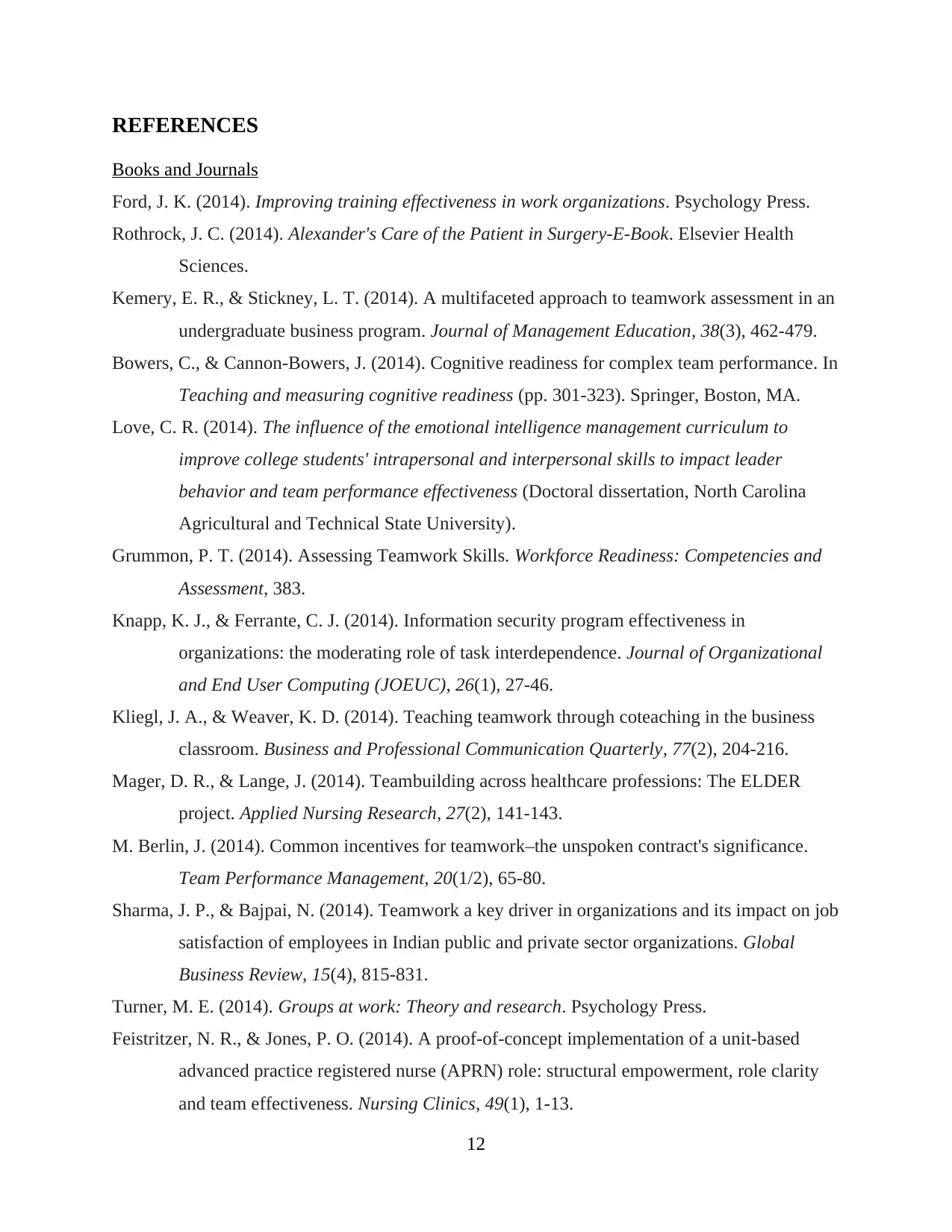
REFERENCES
Books and Journals
Ford, J. K. (2014). Improving training effectiveness in work organizations. Psychology Press.
Rothrock, J. C. (2014). Alexander's Care of the Patient in Surgery-E-Book. Elsevier Health
Sciences.
Kemery, E. R., & Stickney, L. T. (2014). A multifaceted approach to teamwork assessment in an
undergraduate business program. Journal of Management Education, 38(3), 462-479.
Bowers, C., & Cannon-Bowers, J. (2014). Cognitive readiness for complex team performance. In
Teaching and measuring cognitive readiness (pp. 301-323). Springer, Boston, MA.
Love, C. R. (2014). The influence of the emotional intelligence management curriculum to
improve college students' intrapersonal and interpersonal skills to impact leader
behavior and team performance effectiveness (Doctoral dissertation, North Carolina
Agricultural and Technical State University).
Grummon, P. T. (2014). Assessing Teamwork Skills. Workforce Readiness: Competencies and
Assessment, 383.
Knapp, K. J., & Ferrante, C. J. (2014). Information security program effectiveness in
organizations: the moderating role of task interdependence. Journal of Organizational
and End User Computing (JOEUC), 26(1), 27-46.
Kliegl, J. A., & Weaver, K. D. (2014). Teaching teamwork through coteaching in the business
classroom. Business and Professional Communication Quarterly, 77(2), 204-216.
Mager, D. R., & Lange, J. (2014). Teambuilding across healthcare professions: The ELDER
project. Applied Nursing Research, 27(2), 141-143.
M. Berlin, J. (2014). Common incentives for teamwork–the unspoken contract's significance.
Team Performance Management, 20(1/2), 65-80.
Sharma, J. P., & Bajpai, N. (2014). Teamwork a key driver in organizations and its impact on job
satisfaction of employees in Indian public and private sector organizations. Global
Business Review, 15(4), 815-831.
Turner, M. E. (2014). Groups at work: Theory and research. Psychology Press.
Feistritzer, N. R., & Jones, P. O. (2014). A proof-of-concept implementation of a unit-based
advanced practice registered nurse (APRN) role: structural empowerment, role clarity
and team effectiveness. Nursing Clinics, 49(1), 1-13.
12
Books and Journals
Ford, J. K. (2014). Improving training effectiveness in work organizations. Psychology Press.
Rothrock, J. C. (2014). Alexander's Care of the Patient in Surgery-E-Book. Elsevier Health
Sciences.
Kemery, E. R., & Stickney, L. T. (2014). A multifaceted approach to teamwork assessment in an
undergraduate business program. Journal of Management Education, 38(3), 462-479.
Bowers, C., & Cannon-Bowers, J. (2014). Cognitive readiness for complex team performance. In
Teaching and measuring cognitive readiness (pp. 301-323). Springer, Boston, MA.
Love, C. R. (2014). The influence of the emotional intelligence management curriculum to
improve college students' intrapersonal and interpersonal skills to impact leader
behavior and team performance effectiveness (Doctoral dissertation, North Carolina
Agricultural and Technical State University).
Grummon, P. T. (2014). Assessing Teamwork Skills. Workforce Readiness: Competencies and
Assessment, 383.
Knapp, K. J., & Ferrante, C. J. (2014). Information security program effectiveness in
organizations: the moderating role of task interdependence. Journal of Organizational
and End User Computing (JOEUC), 26(1), 27-46.
Kliegl, J. A., & Weaver, K. D. (2014). Teaching teamwork through coteaching in the business
classroom. Business and Professional Communication Quarterly, 77(2), 204-216.
Mager, D. R., & Lange, J. (2014). Teambuilding across healthcare professions: The ELDER
project. Applied Nursing Research, 27(2), 141-143.
M. Berlin, J. (2014). Common incentives for teamwork–the unspoken contract's significance.
Team Performance Management, 20(1/2), 65-80.
Sharma, J. P., & Bajpai, N. (2014). Teamwork a key driver in organizations and its impact on job
satisfaction of employees in Indian public and private sector organizations. Global
Business Review, 15(4), 815-831.
Turner, M. E. (2014). Groups at work: Theory and research. Psychology Press.
Feistritzer, N. R., & Jones, P. O. (2014). A proof-of-concept implementation of a unit-based
advanced practice registered nurse (APRN) role: structural empowerment, role clarity
and team effectiveness. Nursing Clinics, 49(1), 1-13.
12
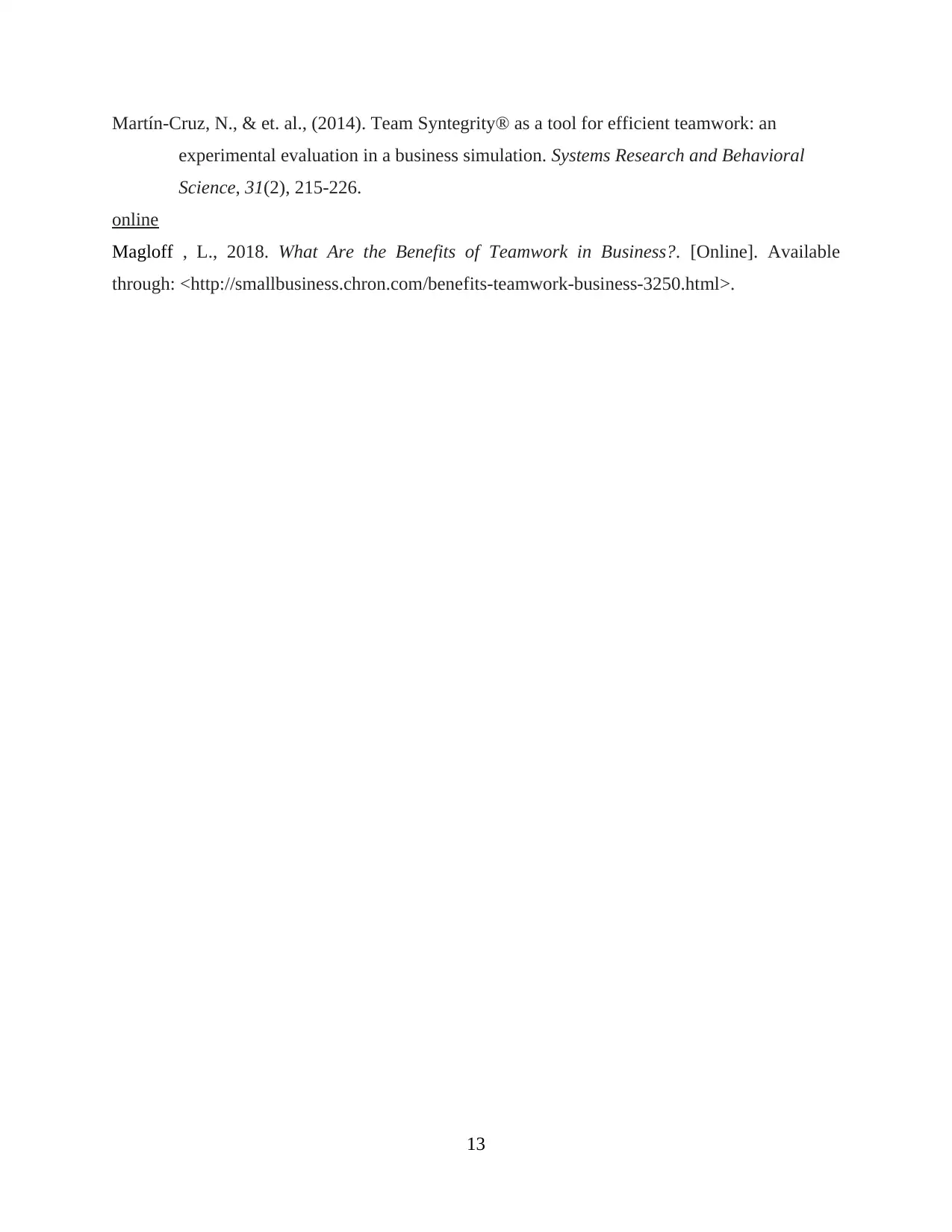
Martín‐Cruz, N., & et. al., (2014). Team Syntegrity® as a tool for efficient teamwork: an
experimental evaluation in a business simulation. Systems Research and Behavioral
Science, 31(2), 215-226.
online
Magloff , L., 2018. What Are the Benefits of Teamwork in Business?. [Online]. Available
through: <http://smallbusiness.chron.com/benefits-teamwork-business-3250.html>.
13
experimental evaluation in a business simulation. Systems Research and Behavioral
Science, 31(2), 215-226.
online
Magloff , L., 2018. What Are the Benefits of Teamwork in Business?. [Online]. Available
through: <http://smallbusiness.chron.com/benefits-teamwork-business-3250.html>.
13
1 out of 15
Related Documents
Your All-in-One AI-Powered Toolkit for Academic Success.
+13062052269
info@desklib.com
Available 24*7 on WhatsApp / Email
![[object Object]](/_next/static/media/star-bottom.7253800d.svg)
Unlock your academic potential
© 2024 | Zucol Services PVT LTD | All rights reserved.





